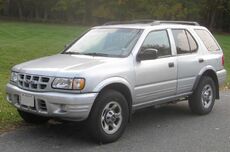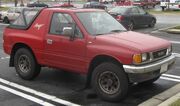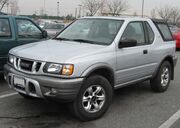 2001–2003 Isuzu Rodeo 4-door (US) | |
| Manufacturer | Isuzu Motors |
|---|---|
| Production | 1989–2004 |
| Successor |
Isuzu Ascender (North America) Isuzu MU-7 (Southeast Asia) |
| Class | Compact SUV |
| Body style(s) |
3-door wagon 5-door wagon |
| Layout | Front engine, rear-wheel drive / four-wheel drive |
The Isuzu Wizard was a five-door compact SUV that was produced by the Japan-based manufacturer Isuzu. The five-door Wizard was introduced in 1990 after the three-door Isuzu MU from 1989, both of which ceased production in 2004. Isuzu manufactured several variations to the Wizard/MU for sale in other countries.
The long-wheelbase (five-door) version was available as the Isuzu Wizard in Japan, and as the Isuzu Rodeo and the Honda Passport in the United States, Canada and Mexico. Opel/Vauxhall and Holden each also sold rebadged versions of the vehicle as the Opel Frontera, Vauxhall Frontera, and Holden Frontera. It was also sold as the Chevrolet Frontera in Egypt, the Isuzu Cameo and Isuzu Vega in Thailand, the Isuzu Frontier in South America, and as Chevrolet Rodeo in Ecuador, Colombia, Venezuela and Bolivia.
The short-wheelbase (three-door) version was sold as the Isuzu MU and Honda Jazz in Japan, with the names Isuzu Amigo and later Isuzu Rodeo Sport used in the United States, Canada and Mexico. Throughout continental Europe, the three-door was called Opel Frontera Sport, with the Vauxhall Frontera Sport title used in the United Kingdom, and Holden Frontera Sport in Australasia.
First generation (1989–1998)[]
 Isuzu Rodeo (US) | |
| Production |
1989–1998 1993–???? (Thailand) 1998– (Egypt) |
|---|---|
| Assembly |
Japan Egypt: 6th of October City[1] Thailand: Rayong United Kingdom: Luton United States: Lafayette, Indiana |
| Engine(s) |
2.6 L I4 3.2 L V6 2.5 L I4 (diesel) 4JA1 (Cameo) 2.8 L I4 (turbo diesel) |
| Wheelbase |
SWB: 91.7 in (2329 mm) LWB: 108.7 in (2761 mm) |
The three-door Isuzu MU made its debut in Japan during 1989, with the five door Isuzu Wizard introduced the following year. Rear- and four-wheel drive configurations were available.
North America[]
Sales of the three-door began in the United States during the second quarter of 1989 under the "Isuzu Amigo" name. A 2.3-liter 4ZD1 inline-four engine, producing 76 kilowatts (102 hp) came standard with the RWD and the 4WD was offered with the 2.6-liter 4ZE1 engine. The transmission was initially manual only. There were very limited options for the early Amigo including air conditioning, seating for two or four, and two trim levels to choose from, S or XS. Some of the model year changes throughout production included: small cosmetic alterations for 1991, the standardization of the 2.6-liter engine for 1992, and the added availability of a four-speed automatic transmission on the RWD version for 1992 and 1993. No major changes were made for 1993, but for 1994, a high mount rear stop light was added, power steering and mirrors were made standard. The Amigo was dropped by Isuzu in the US market in 1994. A limited number of XS-F editions (with the "F" standing for "Frontera") were produced which had a additional options such as power windows and locking, four-wheel anti-lock brakes (ABS) (inactive in low-range 4WD mode, only active on the rear wheels in 4WD high-range). This version of the Amigo had only 49-state emissions (reasons unknown) and there are no official sales numbers, although most dealers agree there were less than 75 sold. The only badging that shows this model is a sport blue "XS" symbol with a sport-font "F" beside it (also sport blue).

1990–1994 Isuzu Amigo XS (US)

1995–1998 Isuzu Wizard 3.1 D Turbo Type X (UCS69GW; Japan)
Isuzu introduced the five-door "Isuzu Rodeo" to the United States in 1990 for the 1991 model year. It was available with either a 2.6-liter inline-four engine rated at 89 kilowatts (119 hp) or a 3.1-liter V6 engine made by General Motors (GM) which had the same power output as the 2.6, but had more torque. An automatic transmission was available for the V6. The Rodeo, like the Amigo was available in both RWD and 4WD, with the latter featuring manually locking hubs on the S version and automatically locking hubs on the XS and top-of-the-line LS. Rear-wheel ABS were standard feature on 4WDs. A RWD manual transmission model with a 21.9 US gal (83 L) tank was rated at 18 mpg-US (13 L/100 km) in city driving by the United States Environmental Protection Agency, and 22 mpg-US (11 L/100 km) on the highway. A 4WD model with the V6 and automatic transmission was rated at 15 mpg-US (16 L/100 km) city and 18 mpg-US (13 L/100 km) highway.
All Rodeos had a rear seat bottom which folded forward and rear seat back which folded down, extending the 35-cubic-foot (990 L) cargo area. The vehicle's lug wrench was stored under the seat bottom, concealed by a carpeted Velcro flap. The jack was located behind a plastic panel in the rear left of the cargo area along with the rear windshield washer fluid reservoir if equipped. The LS was available with privacy glass, velour upholstery, and split-folding rear seats. A secret locking compartment was fitted in the depths of the center console below a removable cassette storage bin. The vehicle weighed 3,490–3,820 pounds (1,580–1,730 kg), depending on engine and options.
For the 1993 model year, Isuzu replaced the GM V6 engine with their own 3.2-liter 24-valve SOHC V6 which was rated at 130 kilowatts (170 hp). Manually-locking hubs were eliminated, but the floor-mounted transfer case shifter remained. The 1993 Rodeo featured a recalibrated suspension system, softened spring rates and softened shock valving. The Rodeo now weighed between 3,536–4,120 pounds (1,604–1,869 kg) and the EPA rating was 18 mpg-US (13 L/100 km) city and 21 mpg-US (11 L/100 km) highway. Also for 1993, a Family II four-cylinder engine from Holden was introduced, and the Rodeo gained a third brake light above the rear window and a more refined center console. The "V6" badge on V6 models was moved behind the front wheels. Midway through 1995, the Rodeo received an updated dashboard and steering wheel, both of which added airbags. The "ISUZU" badge on the front grille also shrunk in size. For 1996 Isuzu increased the power of their 3.2-liter V6 up to 145 kilowatts (194 hp) and 262 N·m (193 lb·ft) of torque, and the top level trim "LS" received the same 16-inch aluminium wheels as the Trooper, and was available in two-tone exterior colors.
Isuzu sold 24,612 Rodeos in 1991 and 45,257 Rodeos in 1992.[2] US models were manufactured at Subaru-Isuzu Automotive, Inc. (now, Subaru of Indiana Automotive, Inc.) in Lafayette, Indiana. Isuzu was rumored to prefer the "RO-dee-o" pronunciation over "ro-DAY-o".[citation needed] The vehicle was still considered an import, as 75 percent of its parts were made overseas.[3]
Europe[]

1995–1998 Holden Frontera (UT) Sport hardtop (Australia)
The Wizard was known in the United Kingdom as the "Vauxhall Frontera" and in Europe as the "Opel Frontera". It was originally built at the former Bedford Vehicles factory in Luton, UK; it would become known as the IBC factory (Isuzu Bedford Company). In the 1980s the plant had come under joint control between Isuzu and General Motors, with the Frontera being built alongside a number of other commercial vehicle models. The Australian and New Zealand version of the Wizard model range was known as the Holden Frontera.
The early cars (to 1995) had a choice of engines, with the LWB available with either a 2.4-liter petrol (C24NE) engine (developed in the Opel Manta 400) or the 2.3-liter diesel engine originally fitted in the Bedford CF van & Vauxhall Carlton. The Frontera sport (Isuzu Amigo) was available with the 2.0-liter petrol Vauxhall Cavalier engine (C20NE).
In 1995 the model went through a facelift and the Frontera received rear coil springs and a new line up of engines. The SWB gained a new 2.0-liter petrol (X20 series) engine, updated trim, and also the first diesel engine available for the SWB, the 2.8-liter (4JB-TC). The LWB also had new engines, with the 2.2-liter petrol (X22XE) and the 2.8 diesel 4JB-TC being made available.
In the 1996–1997 models interior trim, including the dashboard, was changed, and a new 2.5-liter diesel (VM41) engine was fitted. This engine was also used in the Range Rover Classic and Jeep Cherokee in the UK.
China[]
Jiangling (Jiangling Motors Corporation Limited) Landwind in China produces a copy of the Isuzu Rodeo for the Chinese market. It is the first SUV to fail the EuroNCAP crash tests. The Jiangling Motors Landwind is based on the first generation Rodeo although there was no collaboration between JMC and Isuzu or GM. While the Landwind looks like the Rodeo it is not an Isuzu vehicle.[citation needed]
Thailand[]
The Wizard was sold as the Isuzu Cameo (1993-1996) and Isuzu Vega (1999-2004) in Thailand. The Cameo using a 2.5-liter 4JA1 diesel direct injection engine, producing 90 horsepower at 3900 rpm and the maximum torque at 17.8 kgm at 1800 rpm[4] came standard. The transmission was 5-speed manual with rear wheel drive only. The accessory is the same as the TF and the only body style available is a five door wagon.
In 1999, Isuzu decided to have a major change for Cameo and gave it new name "Vega", equipped with four-wheel drive only. Exterior differences from Cameo including the new frontal design, Xenon Headlights, 15-inch wheels came with 265/70R15 tires and the spare wheel on the back door. It introduced with 2.8-liter 4JB1 and the brand new 3.0-liter 4JH1-T turbo diesel, producing 120 horsepower (88 kw) at 3800 rpm and maximum torque at 24.5 kgm at 2000 rpm[5], because of the development of the CCI (ISUZU Computer Controlled Injection) and HPI (ISUZU High Pressure Fuel Injection). In addition, it connected with a choice of 5-speed manual and "Technomatics" 4-speed automatic controlled by the TCM system (Transmission Control Module). The driver can manually choose style of driving by "Normal mode" and "Power mode"
Second generation (1998–2004)[]
 1998–2000 Isuzu Rodeo (US) | |
| Production | 1998–2004 |
|---|---|
| Assembly |
Japan United States: Lafayette, Indiana Tunisia: Kairouan (IMM) |
| Engine(s) |
2.2 L I4 3.2 L V6 3.5 L V6 |
| Wheelbase |
SWB: 2,460 mm (96.9 in) LWB: 2,700 mm (106.4 in) |
The Wizard and MU were redesigned in 1998.
North America[]

1998-2000 Isuzu Amigo (US)

2001–2003 Isuzu Rodeo Sport (US)
The Amigo made a comeback in the US for 1998 with the second generation model. Both the Amigo and Rodeo were built in the assembly plant in Lafayette, Indiana. Amigo came standard with a soft top. Exterior differences in the Amigo and Rodeo other than the wheelbase includes a rear mounted spare tire, 16-inch wheels, and larger fender flares. Standard features on the Amigo included split folding rear seats, tilt steering, dual power ports, power windows, mirrors and door locks, keyless entry and AM/FM CD players. The second series Amigo seats four people comfortably, however it can seat up to five. Amigos with the 130-horsepower (97 kW) 2.2-liter Vortec inline-four engine are few and far between, mainly because previous owners complained to Isuzu that a V6 needed to be standard. Although a small SUV, it still weighed 4,250 pounds (1,930 kg), needing a lot of horsepower for everyday driving. Isuzu’s answer to this was the 3.2-liter, 205 hp (153 kW) 6VD1 V6 that carried 214 pound-feet (290 N·m) of torque at 3,000-rpm which is the same motor that the Rodeo carried. Fuel consumption is an estimated 22 mpg-US (11 L/100 km) highway. From a technical prospective, the Amigo is built with a rigid frame that has eight crossmembers. Front suspension has independent lower and upper arms, with a solid rear axle. Riding in the Amigo can feel much like a full-size truck, feeling a lot of bumps in the road. All units came with pink airbags and side impact door beams, as well as ABS. The Amigo came standard with Isuzu’s 10-bolt rear axle and a push button four-wheel drive button. Amigo also has a traditional floor mounted lever for switching from high- to low-range. The Amigo was renamed in 2001 to the "Rodeo Sport" to compliment the more successful five-door Rodeo. The Amigo series was produced until 2003, while the Rodeo was dropped in 2004.
For the five-door Rodeo, adjustable shock absorbers were new this year and 16-inch tires replaced all 15-inch versions, as Isuzu redesigned the front and rear fascias of this midsize SUV. Standard on the LSE and optional on LS, the new Intelligent Suspension Control featured a dashboard button to adjust shock damping between sport and normal settings. Honda Passports did not get the adjustable-shock system. A new Ironman package debuted for the LS, marking Isuzu's sponsorship of the Ironman triathlon competition. The package included white or black paint over grey lower body panels, crossbars for the roof rack, and special graphics. Cruise control now was standard on V6 Rodeos, and an automatic transmission became standard on the LSE edition.

2004 Isuzu Rodeo (US)
- 2001: in celebration of Isuzu's 85th year, an Anniversary Edition was added, along with a revised Ironman Package for 2001. In addition, the Rodeo receives a new grille.
- 2002: last model year for Rodeo sales in Canada, replaced by the Saturn Vue as a result of Isuzu withdrawing from Canada after the 2002 model year. Isuzu dealerships in Canada also sold Saturns and Saabs.
- 2003: no significant changes for 2003.
- 2004: the Rodeo loses its three-door model and four-cylinder engine for 2004, but gains a new optional 3.5-liter 250 horsepower (190 kW) engine. Added midyear was a standard tire-pressure monitor. In addition, the SUV received its final facelift.
In 2004, Isuzu dropped the inline-four engine and added the optional 3.5-liter V6 gasoline direct injection (GDI) engine with 250 horsepower (190 kW) and 246 pound-feet (334 N·m) of torque. Isuzu was the first to offer (GDI) in a vehicle priced under US$100,000. The Rodeo weighs in at a little over 3,800 pounds (1,700 kg), with an EPA estimated gas mileage for 2007 of 16 mpg-US (15 L/100 km) city and 22 mpg-US (11 L/100 km) highway for the two wheel drive model, and 15 mpg-US (16 L/100 km) city and 20 mpg-US (12 L/100 km) highway for the four wheel drive model.
Europe[]

Opel Frontera
After General Motors took full control over the IBC Vehicles factory in 1998, the Frontera production line was planned to be transferred to General Motors' Vauxhall plant in Ellesmere Port. However with the closure of the Vauxhall Luton plant the decision to move was reversed. In 1998 the new model series was introduced with a choice of 2.2- petrol, 2.2-liter diesel (X22DTH) and 3.2-liter V6 petrol engines. Further modifications where carried out on the diesel engine post-2001, with the final version to be fitted in the marque being the 2.2-liter (Y22) version. This model met the Euro 4 Emissions standard.
The Frontera was discontinued from production at IBC Luton in 2004 (the final models in the UK were produced in Olympus trim). In Australia and New Zealand, the Holden Frontera was replaced by a Holden badged version of the Chevrolet Captiva model range.
References[]
| This page uses some content from Wikipedia. The original article was at Isuzu Wizard. The list of authors can be seen in the page history. As with Tractor & Construction Plant Wiki, the text of Wikipedia is available under the Creative Commons by Attribution License and/or GNU Free Documentation License. Please check page history for when the original article was copied to Wikia |
- ↑ Satyam. "GM Egypt History". GM Egypt. Retrieved on 2010-07-19.
- ↑ Mateja, Jim. M-_21_|D-_235_|Y-_1993_|resultStructure-combined&revlogtype=19&makeid=21&modelid=235&year=1993&myid=&revlogtype=19&aff=national 1993 Isuzu Rodeo Review. Cars.com, republished from Chicago Tribune, 31 January 1993.
- ↑ Truett, Richard. 1993 Isuzu Rodeo Review. Cars.com, republished from Orlando Sentinel, 21 October 1993.
- ↑ "Cameo profile (Thai language)". cameo-club.com. Retrieved on 2011-01-14.
- ↑ "Vega profile (Thai language)". Yan Yon magazine no.415 December 2000 (2000-12-03). Retrieved on 2011-01-16.
| Isuzu road vehicle timeline, United States market, 1980s–2008 | |||||||||||||||||||||||||||||
|---|---|---|---|---|---|---|---|---|---|---|---|---|---|---|---|---|---|---|---|---|---|---|---|---|---|---|---|---|---|
| Type | 1980s | 1990s | 2000s | ||||||||||||||||||||||||||
| 0 | 1 | 2 | 3 | 4 | 5 | 6 | 7 | 8 | 9 | 0 | 1 | 2 | 3 | 4 | 5 | 6 | 7 | 8 | 9 | 0 | 1 | 2 | 3 | 4 | 5 | 6 | 7 | 8 | |
| Subcompact car | I-Mark | I-Mark | |||||||||||||||||||||||||||
| Compact car | Impulse | Impulse | |||||||||||||||||||||||||||
| Stylus | |||||||||||||||||||||||||||||
| Compact SUV | VehiCROSS | ||||||||||||||||||||||||||||
| Amigo | Amigo / Rodeo Sport | ||||||||||||||||||||||||||||
| Mid-size SUV | Rodeo | Rodeo | |||||||||||||||||||||||||||
| Axiom | |||||||||||||||||||||||||||||
| Trooper | Trooper | Trooper | Ascender | ||||||||||||||||||||||||||
| Minivan | Oasis | ||||||||||||||||||||||||||||
| Pickup | P'up | Pickup | Hombre | i-Series | |||||||||||||||||||||||||
| Note - "This list need updating for 2009, 2010, and 2011 models and similar timelines for other markets creating" | |||||||||||||||||||||||||||||